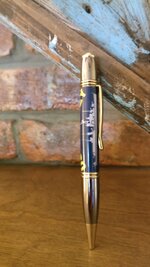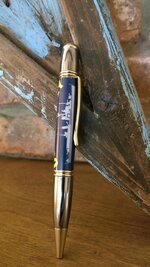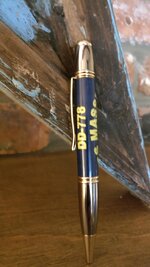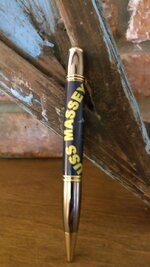Texas Taco
Member
| I don't know why I waited so long to do this pen. I had a distant cousin that was killed during the battle at Midway. If you've ever watched the 1976 movie, Midway, then you were introduced to "LEM." |




A little history behind the pen. . .
From the ship's Wikipedia page
USS Massey (DD-778), an Allen M. Sumner-class destroyer, was a United States Navy ship that served between 1944 and 1973. The ship was named for Lance Edward Massey, World War II naval aviator.
This was the only ship of the United States Navy to be named for Lieutenant Commander Lance Edward Massey, who was awarded the Distinguished Flying Cross for extraordinary achievement in aerial combat as leader of a group of nine torpedo planes in action against enemy Japanese surface vessels at Kwajalein Atoll, Marshall Islands, on 1 February 1942. During the Battle of Midway on 4 June 1942, Massey, commanding Torpedo Squadron 3, repeated this achievement as he led his squadron against Japanese naval units despite "intense antiaircraft fire and overwhelming fighter opposition." His squadron, bolstered by "his courageous initiative and self‑sacrificing gallantry", pressed home their attack on two enemy aircraft carriers. Massey, his plane shot down during the battle, was posthumously awarded the Navy Cross for his courage, gallantry, and leadership during this decisive encounter.
From the Wikipedia page on LEM. . .
Lance Edward "Lem" Massey (September 20, 1909 – June 4, 1942) was a U.S. Navy pilot during World War II.
| Lt Cdr Massey at NAS Ford Island on 24 May 1942. The victory flag marking on his TBD Devastator represents a Japanese ship he sank at Kwajalein during the Marshalls-Gilberts raids. |
He was a native of Syracuse, New York, and was the only child of Walter Griffith Massey and Florence Lance Massey. Growing up in Watertown, New York, he attended two years of high school in Watertown, and then entered Severn School in Severna Park, Maryland, in 1925. After graduating from Severn in 1926, he was accepted into the U.S. Naval Academy when he was sixteen.
After graduating from the Naval Academy in 1930, he was given his commission as an ensign, and he was ordered to the battleship USS Texas (BB-35). After serving for a year aboard the USS Texas he entered flight training in Pensacola Naval Air Station in 1931 and won his Naval Aviator wings in January 1932. He was assigned to Scouting Squadron 3 aboard the aircraft carrier USS Lexington (CV-2) for the next three years. He subsequently served a two-year tour at Pensacola Naval Air Station in Florida as a flight instructor. While at Pensacola, he married Marjorie Drake Kelsey, the widow of Lieutenant (j.g.) James Kelsey, a 1931 graduate of the US Naval Academy. In June 1937, Lieutenant (jg) Massey reported to Observation Squadron 3 aboard the battleship USS New Mexico (BB-40), whose home port was Long Beach, California. In August 1937, he was promoted to lieutenant. In January 1940, Observation Squadron Three was transferred to the USS Idaho (BB-42), where he stayed until July 1940, when he was sent to Naval Air Station, Pensacola. In October 1941, he was reassigned to the USS Enterprise (CV-6) as the Executive Officer of Torpedo Squadron 6 (VT-6), the post he held at the time the United States was attacked by Japan in December 1941.
He was promoted to the rank of lieutenant commander in January 1942. His sole combat mission from Enterprise occurred on February 1, 1942, during the Marshalls-Gilberts raids, when he led VT-6's Second Division in the first airborne torpedo attack in U.S. Naval history. His nine TBD torpedo bombers attacked Japanese shipping at Kwajalein Atoll in the Marshall Islands, with Massey personally sinking the 18,000-ton Japanese transport Bordeaux Maru. For this action, he was awarded the Distinguished Flying Cross.
Midway
On April 14, 1942, he took command of Torpedo Squadron Three (VT-3), a Saratoga squadron then based at Kaneohe Naval Air Station. On May 27, 1942, VT-3 was transferred to USS Yorktown following the Battle of the Coral Sea, replacing that ship's own Torpedo Squadron 5 (VT-5). The USS Yorktown sailed with VT-3 for Midway Island and entered battle on June 4, 1942. During this crucial encounter, Massey was killed while leading his squadron in a low-level attack against the Japanese aircraft carrier Hiryū. Despite being escorted by six F4F Wildcat fighters led by Lieutenant Commander John Thach,[2] ten out of VT-3's twelve TBD's were lost. For his heroism in pursuing the attack on Hiryu, Massey was posthumously awarded the Navy Cross.[3]
In memory of his actions at the Battle of Midway, the U.S. Navy christened the destroyer USS Massey (DD-778) on August 19, 1944, with his widow Marjorie Massey christening the ship. In addition to his widow, he was survived by two sons, Lance Bradford Massey and Walter Drake Massey, both whom graduated from the Severn School. Lance B. Massey graduated from the U.S. Naval Academy in 1958 and retired as a Commander in 1984.
